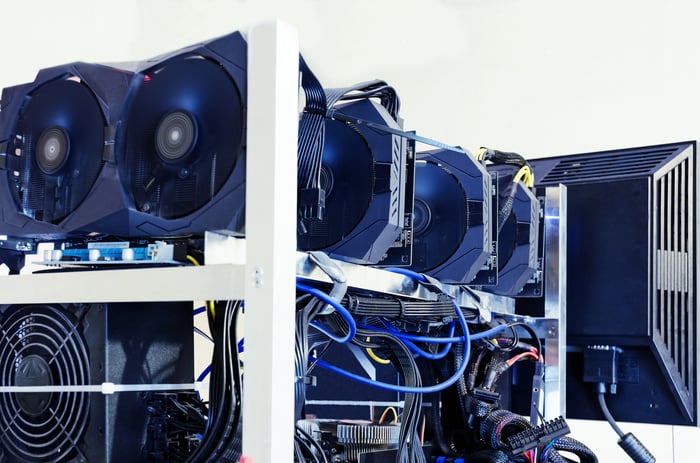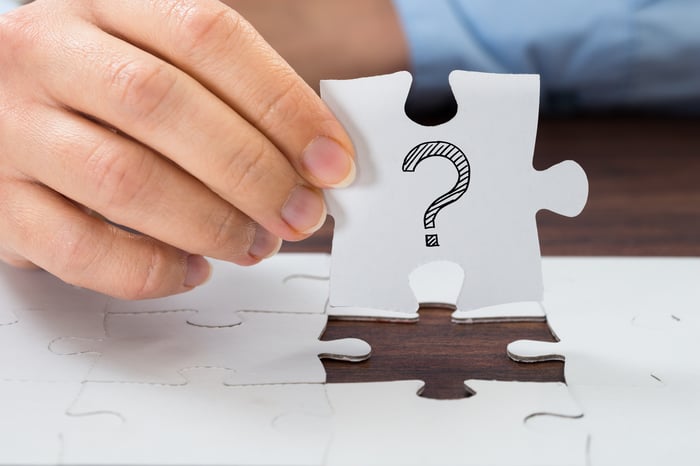Historically, no asset has been a greater source of wealth creation than the stock market. Throughout its history, stocks have returned an average of 7% per year, inclusive of dividend reinvestment, and when adjusted for inflation. For the average long-term investor, this works out to a roughly doubling in value about once a decade.
Then cryptocurrencies came along and turned this traditional source of wealth creation on its head. When 2017 began, the aggregate value of all digital currencies combined equaled just $17.7 billion. However, as recently as this past weekend, the combined market cap of the nearly 1,400 investable cryptocurrencies was almost $836 billion. That better than 4,500% increase in value is something that the stock market would take multiple decades to accomplish.
Yet, truth be told, most folks don't understand the basics of cryptocurrencies, or the blockchain technology that underlies them. Recently, we broke down what cryptocurrencies are in the easiest way possible. Today, we're going to explain, in plain English, what blockchain technology is all about.

Image source: Getty Images.
What is blockchain technology?
Blockchain is the digital and decentralized ledger that records all transactions. Every time someone buys digital coins on a decentralized exchange, sells coins, transfers coins, or buys a good or service with virtual coins, a ledger records that transaction, often in an encrypted fashion, to protect it from cybercriminals. These transactions are also recorded and processed without a third-party provider, which is usually a bank.
Why was blockchain invented?
The main reason we even have this cryptocurrency and blockchain revolution is as a result of the perceived shortcomings of the traditional banking system. What shortcomings, you ask? For example, when transferring money to overseas markets, a payment could be delayed for days while a bank verifies it. Many would argue that financial institutions shouldn't tie up cross-border payments and funds for such an extensive amount of time.
Likewise, banks almost always serve as an intermediary of currency transactions, thus taking their cut in the process. Blockchain developers want the ability to process payments without a need for this middleman.

Image source: Getty Images.
What are its prime advantages over current networks?
So, what does blockchain technology bring to the table that current payment networks don't? For starters, and as noted, it's decentralized. That's a fancy way of saying that there's no central hub where transaction data is stored. Instead, servers and hard drives all over the world hold bits and pieces of these blocks of data. This is done for two purposes. First, it ensures that no one party can gain control over a cryptocurrency and blockchain. Also, it keeps cybercriminals from being able to hold a digital currency "hostage" should they gain access to transaction data.
Second, removing the middleman from the equation and working around the traditional banking system should allow for smaller transaction fees. What's unclear is if lower fees would mean cheaper fees for the consumer, or just bigger profits for businesses deploying blockchain technology.
Third, and maybe most important, blockchain offers the potential to process transactions considerably faster. Whereas banks are often closed on the weekend, and operate during traditional hours, validation of transactions on a blockchain occur 24 hours a day, seven days a week. Some blockchain developers have suggested that their networks can validate transactions in a few seconds, or perhaps instantly. That would be a big improvement over the current wait time for cross-border payments.

Image source: Getty Images.
What are the disadvantages?
However, blockchain isn't perfect, and it does have some clear drawbacks.
One obvious hurdle is the adoption of the technology. To deploy blockchain, financial institutions would essentially have to abandon their current networks and start anew. Trying to integrate the current payment networks with blockchain could prove exceptionally challenging -- to the point where some businesses don't even bother trying to do so. It's also still unclear, with the exception of bitcoin (CCY: BTC-USD), the world's most popular cryptocurrency, if any blockchain aside from bitcoin could survive being scaled to handle a lot of transactions.
Blockchain can also, depending on the circumstance, be very energy dependent, and therefore costly. When transactions are being verified (which we're going to talk about in the next section), it's possible that a lot of electricity can be used. This is the case in point with bitcoin, which is why so few cryptocurrency miners actually find that validating transactions on bitcoin's blockchain is worthwhile (and profitable).
Differentiation of blockchain networks is also a concern. Right now, there are close to 1,400 cryptocurrencies, and many have their own versions of blockchain technology. It's unclear which few will rise to the front of the pack, or which blockchains businesses will prefer. What's in favor now could quickly become yesterday's news.

Image source: Getty Images.
How are blockchain transactions validated?
Processing transactions on blockchain also comes with the issue of ensuring that the same cryptocurrency coin isn't being spent twice. That's where transaction validation comes into play.
There are two primary ways that transactions on blockchain are validated: proof-of-work (PoW) and proof-of-stake (PoS).
Bitcoin runs on the PoW model. What happens with PoW is that cryptocurrency miners (a fancy term for people with really high-powered computers) compete against one another to solve complex mathematical equations that are a result of the encryption protecting transactions on a blockchain network. The first miner to solve these equations, and in the process validate a block of transactions, receives what's known as a "block reward." For bitcoin, a block reward is paid as a fraction of digital bitcoin.
The other primary validation method is PoS. Rather than using a ton of electricity in a competition to solve equations, the PoS method awards the owners of virtual coins the opportunity to validate transactions in a deterministic fashion. In even plainer terms, the more coins you own of a virtual currency operating on the PoS model, the more likely you are to be chosen to validate blocks and add to the blockchain.
It's worth pointing out that while the PoW method hands out block rewards as virtual coins, the PoS model rewards its stakeholders with the transaction fees paid by the users of the block that's being verified.

Image source: Getty Images.
Is blockchain public or private?
One of the greatest aspects of blockchain technology is the ability for a developer or business to customize it. This means a blockchain can be completely open to the public and allow anyone to join, or it can be totally private, with only certain folks allowed access to the data, or allowed to send and receive payments. Bitcoin is an example of an open-source public blockchain that allows anyone to join, whereas a private blockchain would be perfect for a corporate customer.
Are blockchain transactions anonymous?
Despite popular belief, most blockchain transactions aren't anywhere near as private or anonymous as you'd like to think. Even though you don't have to provide a Social Security number or bank account when buying or selling cryptocurrencies, an analysis of a blockchain can often be traced back to an individual sender or receiving of funds.
A small class of digital currencies known as privacy coins aims to make blockchain-based transactions untraceable. They do this by beefing up the protocols designed to obscure the identity of the sender and receiver of funds, as well as the dollar amount being sent. Yes, privacy coins have been accused of being a haven for the criminal community. However, most privacy coin and blockchain developers also suggest that this is a minute component of their community, and that nearly all members are legitimate consumers and businesses.

Image source: Getty Images.
Does blockchain have applications beyond the financial industry?
Up to this point, you've probably noticed that we've discussed the application of blockchain as a means to improve the financial services industry. But, it may actually have plenty of use beyond the financial sector.
For example, Ethereum (CCY: ETH-USD), which has a nearly $116 billion market cap and is the second-largest cryptocurrency behind bitcoin, currently has 200 organizations testing a version of its blockchain technology. Yes, traditional banks are testing out Ethereum's blockchain, but so are companies in the technology and energy industries. Integrated oil and gas giant BP (BP -1.13%) envisions using a version of Ethereum's blockchain to aid it with energy futures trading. If these transactions were to settle faster, BP could presumably improve its margin.
Blockchain may also offer the ability to replace state ID's that we carry in our wallets, or perhaps help tech companies such as Cisco Systems (CSCO -0.66%) manage their Internet of Things network. Right now, Cisco is working on its own proprietary blockchain technology that can identify different connected devices, monitor the activity of those devices, and determine how trustworthy those devices are. It has the potential to continually "learn" and assess which devices are trustworthy, and if they should be added to a network.
So yes, blockchain is about way more than just sending money.

Image source: Getty Images.
Is blockchain viable on a larger scale?
Lastly, you're probably wondering how viable blockchain is. The honest answer is, "no one knows."
Truth be told, blockchain has been around for almost a decade thanks to bitcoin, but it's only now beginning to garner a lot of attention. Most businesses that are testing blockchain technology are doing so in a very limited capacity (i.e., demos or small-scale projects). No one is entirely certain if blockchain can handle being scaled as so many of its developers have suggested.
Perhaps one of the best real-world examples of blockchain in action is the partnership between Ripple (CCY: XRP-USD) and banking giants American Express (AXP -0.03%) and Banco Santander (SAN -1.51%). It was announced in mid-November that American Express users would be able to send non-card payments to U.K. Santander accounts over AmEx's FX International Payment network and have those transactions processed over Ripple's blockchain. The allure of this partnership is Ripple's instantly settling cross-border payments, as well as the expectation of small transaction fees.
Can blockchain really go mainstream? While that question remains unanswered for now, at least you have a better understanding of what this craze is all about.




